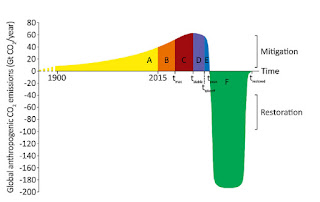Over the last years, the notion of a “
carbon budget” has made it into climate policy parlance. The idea is often expressed as “in order to keep warming below
x degrees, we can only emit
y more tonnes of carbon dioxide”. Straightforward as this may sound, reality is obviously more complicated. Not only are there some remaining uncertainties with regard to “climate sensitivity” (i.e. how much warming each additional ton of carbon dioxide produces) but we must also put the human-generated inflow of carbon dioxide in relation to the rate of natural outflow. Recognizing that climate change is not so much a
flow as a
stock problem, this means that we must make estimates of how long the emitted carbon dioxide stays in the atmosphere. For instance, we know that between 65% and 80% of carbon dioxide released into the air dissolves into the ocean over a period of 20–200 years. The remaining emissions have very long perturbation lifetimes of up to five thousand years. To complicate the picture even further, not all carbon emissions stay in the troposphere where carbon dioxide removal can take place. The remaining emissions go into the stratosphere where neither natural nor artificial removal is currently possible. This means that the role of negative emissions technologies (or NETs) in meeting the carbon budget is limited not only by political, social and economic factors but also atmospheric physics.
It is beyond my scientific competence to say what all this means for the notion of a fixed carbon budget. Writing in the journal
Anthropocene, Adam Dorr
recently suggested that we must take a broader view of climate stabilization and what possible restoration curves would look like:
As a very first step, we must stop the growth in emissions. Once this is achieved, we must begin reducing the total amount of carbon dioxide that we add to the atmosphere every year. Only when this amount falls below the rate of natural carbon dioxide removal will the actual concentration of carbon dioxide (currently at 400 ppm) begin to fall and the warming be reversed. The longer we wait with reducing emissions, the greater will the need be to deploy negative emissions technologies if dangerous warming is to be avoided. The problem is that NETs, in addition to their own
instrinsic limitations, are subject to many of the same political economic constraints that are preventing effective mitigation in the first place, in particular the discrepancy between certain upfront cost and uncertain future benefits as well as a paralyzing fragmentation of agency (no single NET project will ever have a discernible effect on the climate).
Unlike NETs,
rapid decarbonization using existing nuclear technologies would produce many immediate local benefits, such as improved air quality and cheaper electricity for consumers. If anything,
visiting Chernobyl further strengthened my support for nuclear as a source of clean, reliable and abundant energy. However, formidable political and psychological barriers remain to its large-scale deployment. Even if the public may eventually come about and realize the necessity of expanding nuclear power, it may soon be that the stock of carbon dioxide in the atmosphere has become so high that dangerous warming is inevitable.











